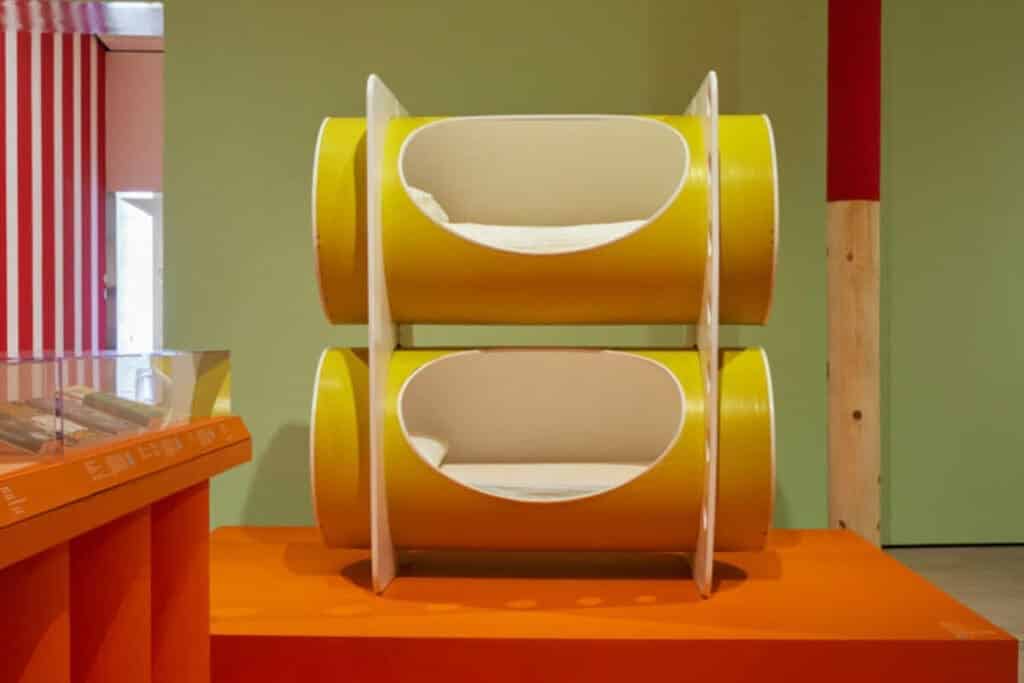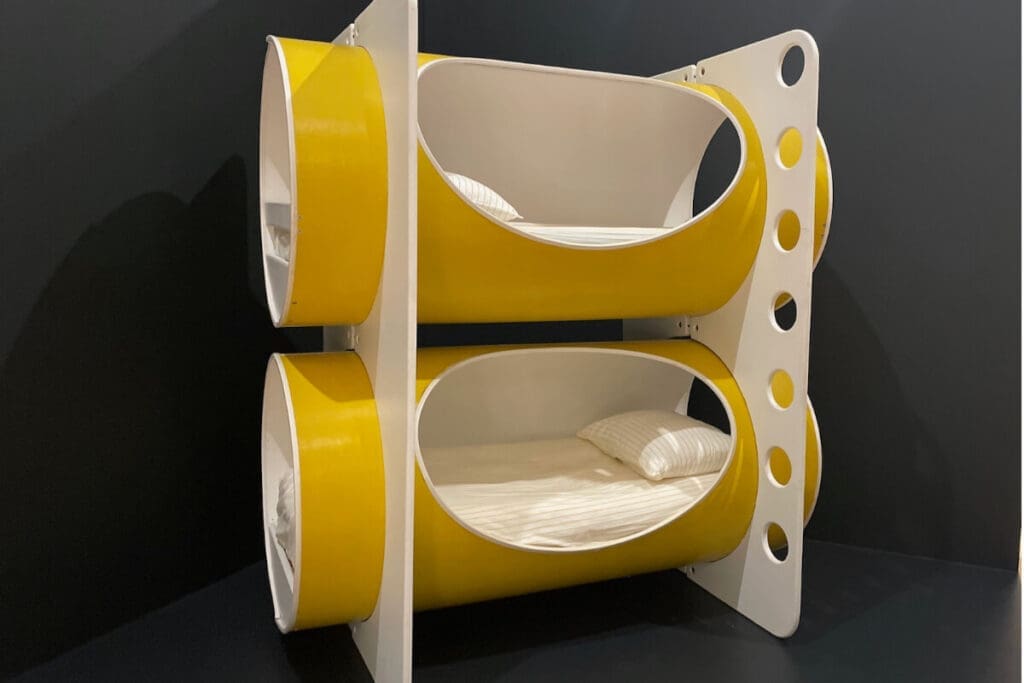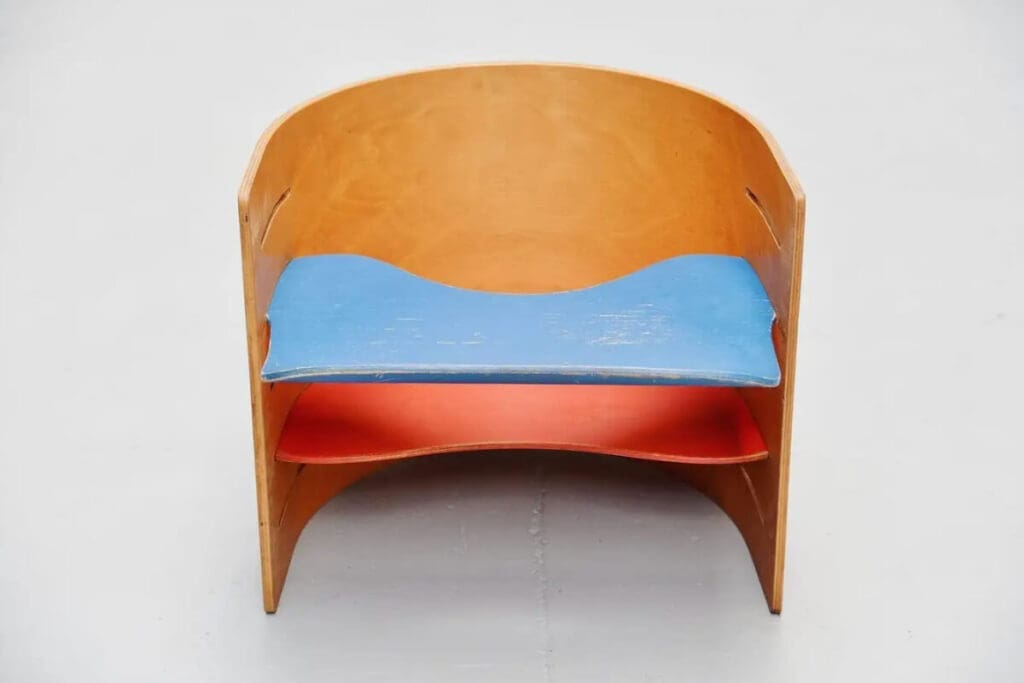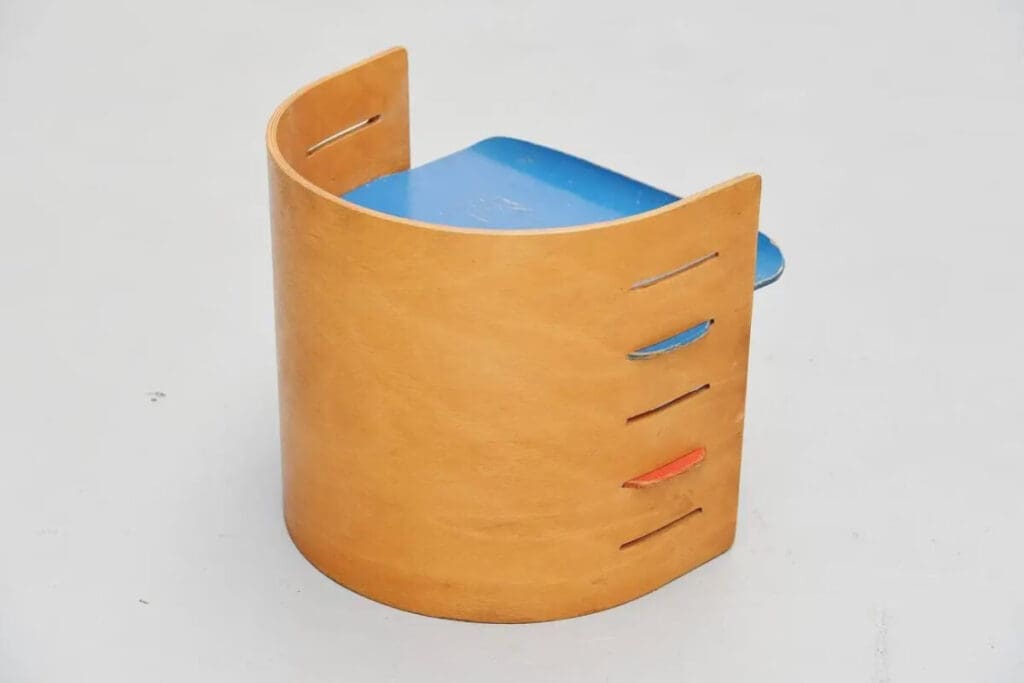Recently at an exhibition on Scadinvanian design at the Milwaukee Museum of Art, I saw an exciting children’s bed called Big Toobs and a Child’s Chair. Both these designs are classic.
In the grand tapestry of design history, there are moments when ideas and innovation blend seamlessly with socio-cultural needs. A classic example of such an intersect is the Made by H.U.D.D.L.E.company, a brainchild of the visionary couple Jim and Penny Hull. Take a journey through their innovative children’s line that changed furniture design and production dynamics. Kristen Vedel also designed a child’s chair in Denmark.
Table of Contents
- Design Innovation Embodied: The Story Of Made By H.U.D.D.L.E.
- Kristian Vedel’s Child’s Chair: An Ode To The Wonders Of Childhood
- Frequently Asked Questions
- Related Content
Design Innovation Embodied: The Story Of Made By H.U.D.D.L.E.

In the rich narrative of design history, there exist instances where ingenious ideas and revolutionary practices perfectly align with societal demands and cultural necessities. One such exemplary moment unfolded with the establishment of Made by H.U.D.D.L.E., a creative endeavor that sprung from the minds of the dynamic duo Jim and Penny Hull.
Jim Hull, born in 1942, and Penny Hull, born in 1943, were California-based designers with a distinct flair for creating simple yet aesthetically pleasing pieces of furniture. In the early 1970s, they founded a company with a peculiar name – Made by H.U.D.D.L.E., which means Hull Urban Design Development Laboratory, Etc.
Their shared mission was to address the glaring gap in the market for children’s furniture that could seamlessly integrate into modern living spaces while also serving as an interactive play element.

Responding to this need, the Hulls designed and introduced “Big Toobs” in 1972, a bed, unlike anything on the market. They looked to Scandinavian design for inspiration, known for its clean lines, minimalistic aesthetic, and strong emphasis on functionality.
The result was a remarkable blend of simplicity and sophistication with a truly American twist.
“Big Toobs,” a curious, charming bed, was made primarily from fiber hardboard, wood, and vinyl. This bed was made from a kind of tube that formed the bed’s sturdy and playful frame, creating a unique, inviting environment for children.
The Hulls’ design philosophy drew parallels with that of Danish designer Kristian Vedel, who was known for his children’s chair design. Like Vedel, the Hulls believed in creating furniture supporting play and functional living.
The Big Toobs bed was a testament to this belief, designed as a piece of furniture that children could interact with, fostering their creativity and imagination. Yet, it served as a comfortable sleeping space.

The unique design of the Big Toobs bed was acknowledged and included in the book “Nomadic Furniture” in 1973, further cementing the Hulls’ place in design history.
The inclusion in this book was fitting, given its focus on affordability and mobility – principles that the Hulls’ design indeed embodied.
The Hulls’ pioneering work through Made by H.U.D.D.L.E. was groundbreaking and continues to resonate today. Their ingenious use of materials, attention to detail, and deep understanding of modern lifestyle needs placed them in the ranks of design visionaries.
They successfully fused practicality and aesthetic appeal, creating a functional and playful design and setting a new standard for children’s furniture design.
Big Toobs Represented Shift In Furniture Industry
The Big Toobs bed represented a paradigm shift in the furniture design industry. By daring to dream and think differently, the Hulls pushed the boundaries of design, material use, and Scandinavian design.
They showed that good design does not necessarily mean expensive or complicated but could be simple, beautiful, and within everyone’s reach.
Big Toobs Came Out Of Their Own Needs With Their Children
Today, Made by H.U.D.D.L.E. and the Big Toobs bed are iconic symbols of forward-thinking furniture. The couple’s remarkable story inspires modern designers, reminding them that innovation often springs from identifying and addressing the most everyday needs.

In this case, the Hulls realized that children’s furniture could serve multiple purposes: facilitating play, supporting everyday living, and nurturing young imaginations. They created a solution that was not only practical but appealing.
The Hulls were not just furniture designers. They were also thoughtful inventors, mindful consumers, and parents who understood the importance of their children’s interaction with the surrounding environment. Their Big Toobs bed was a real-world expression of these multiple roles, offering an innovative solution responsive to the environment.
Design Impact Of H.U.D.D.L.E.
While their company, Made by H.U.D.D.L.E., may not be a household name today, the impact and legacy of the Hulls’ innovative approach to design can still be seen. Their work has influenced a generation of designers who value functionality and thoughtful design.
The Big Toobs bed is a testament to their ingenuity, creativity, and vision.
Indeed, Jim and Penny Hull were trailblazers, their Big Toobs bed a beacon of innovative design. It was a bed ahead of its time, yet it continues to be timeless. Its design principles – sustainability, functionality, and a sense of play – are more relevant today than they’ve ever been
Kristian Vedel’s Child’s Chair: An Ode To The Wonders Of Childhood
The Big Toobs Bed resembles the Danish designer Kristian Vedels, Child’s Chair. Even though they are different designs, they have some similarities.

Kristian Vedel believed every child deserves a space that fosters curiosity, encourages exploration, and caters to constantly evolving needs. Danish designer Kristian Vedel understood this intrinsically, crafting a piece of furniture that genuinely encapsulates the multifaceted world of a child. Enter the Child’s Chair, a playful yet functional piece that captures the spirit of childhood in its very design.
The Child’s Chair, thoughtfully designed, is a piece that can quickly adapt to a child’s dynamic lifestyle. Recognizing that children are not static beings but constantly growing and evolving, Vedel designed the chair to be flexible and multipurpose.

Its adjustable seat can transform from a high chair to a low chair, effortlessly catering to various activities and stages of a child’s development.
However, the versatility of Vedel’s design doesn’t stop there. The chair features a smaller plate that can be added to create a multipurpose table. This transforms the chair into a creative workstation where a child can eat, draw, or play, nurturing their diverse interests.
Furthermore, the chair can be laid on its back, providing a storage solution for toys and other items and showcasing its multi-functionality.
Made from plywood, the Child’s Chair is lightweight, making it easily portable for your child yet incredibly stable. This balance of mobility and stability ensures that the chair is always a safe and secure space for your child to explore their imagination.

Moreover, using plywood, a material known for its durability and resistance to wear and tear, ensures that the Child’s Chair is built to last, ready to accompany your child through the various stages of their childhood.
Kristian Vedel’s Child’s Chair is a testament to a design philosophy that centers around the user’s needs, in this case, children’s ever-changing, playful, and explorative nature. It’s more than just a chair; it’s a space for growth, learning, and endless imagination, designed to nurture your child’s interests. Like a trusty companion, the Child’s Chair grows and adapts with your child, ready to facilitate their next adventure.
Both of these designs, Kristen’s Child’s chair, and Hull’s Big Toobs chair, show that children’s furniture can be so much more than using a chair for sitting or a bed to sleep the furniture can have multi-functions.
Frequently Asked Questions
What is Kristen’s Child’s Chair?
Kristen’s Child’s Chair is a creative and versatile children’s furniture design that goes beyond traditional seating. It’s designed to adapt to different activities, such as reading, playing, and storage.
What makes Hull’s Big Toobs Chair unique
Hull’s Big Toobs Chair is an innovative children’s furniture piece that combines seating with storage. Its cylindrical design allows kids to sit, play, and store toys inside, making it a multi-functional solution.
Why is multi-functional children’s furniture important?
Multi-functional children’s furniture maximizes space efficiency and encourages kids to engage in various activities, promoting creativity and adaptability.
How can Kristen’s Child’s Chair benefit children’s development?
Kristen’s Child’s Chair provides a comfortable spot for reading, drawing, or playing. It supports children’s cognitive and motor skill development while promoting independence.
What materials are typically used for children’s multi-functional furniture like these designs?
Children’s furniture often uses safe and durable materials like wood, plastic, and fabric that are easy to clean and maintain.
Where can one find these innovative children’s furniture designs?
Innovative children’s furniture designs like Kristen’s Child’s Chair and Hull’s Big Toobs Chair can often be found in specialty furniture stores, online retailers, or through designers and manufacturers specializing in unique children’s furniture solutions.
Find out more about how Mondoro can help you create, develop, and manufacture excellent home decor and furniture products – don’t hesitate to contact me, Anita. Check out my email by clicking here or become a part of our community and join our newsletter by clicking here.
Mondoro gives out a FREE Lookbook to anyone interested. You can receive a copy of our latest Lookbook by clicking here.
Listen to our Podcast called Global Trade Gal. You can find it on all major podcast platforms. Try out listening to one of our podcasts by clicking here.
Subscribe to our Mondoro Company Limited YouTube Channel with great videos and information by clicking here.
Related Content
Troll Dolls: Thomas Dam & Made For Dam Things Establishment
Thomas Dam was a baker who was struggling after World War II. He could no longer provide for his family, so he started to carve these iconic troll dolls. The dolls would eventually become so popular that they became a symbol worldwide of innovative and great Scandinavian design. Read on to go into the history of Thomas Dam and his company, Made for Dam Things, and their troll dolls.
You can learn more by reading our blog, Troll Dolls: Thomas Dam & Made For Dam Things Establishment by clicking here.
Scandinavian Design And The United States 1890 – 1980 Impact
The exhibition gave an excellent overview of how Scandinavian designers and design impacted American design and life from 1890 to 1980; this impact continues in the design world even today. Read on as we show you some of what we felt were some of the most exciting designs on display.
To learn more, you can read Scandinavian Design And The United States 1890 – 1980 Impact by clicking here.
Wabi-Sabi: Embracing Imperfection And Transience In Design
In an era where everything is mass-produced to perfection, where symmetry is celebrated, and where glossy, flawless finishes are the norm, the ancient Japanese design philosophy of Wabi-Sabi offers a breath of fresh air. Instead of striving for perfection, Wabi-Sabi celebrates imperfection and sees beauty in the simple, rustic, and imperfect life and design choices.
You can discover more by reading Wabi-Sabi: Embracing Imperfection And Transience In Design by clicking here.

